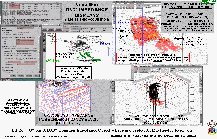|
 DvC1-08 (ST26 "O" Sand VoxelGeo Bypassed Pay) DvC1-08 (ST26 "O" Sand VoxelGeo Bypassed Pay)
Figure DvC1-08 is a montage showing many different aspects of the D3D-impedance investigations of the "O" sand, at the ST-26 field. From lower-left, counter-clockwise:
L-L:An opaque D3D-impedance Time Cube (T'ube), covering an area near the OCS block known as South Timbalier Block 26. A time slice is on the top, showing the numerous wells drilled from the six platforms (one burned, in 1970, and was replaced) constructed by Shell Oil. The "O" sand reservoir is imbedded within this solid block of seismic.
L-R:The same T'ube but with only the (interpreted residual plus remaining productive) "O" sand VOXELs rendered opaque. Note the density of drilling, as shown by the numerous black well paths. The block boundaries are drawn in brown on top of the T'ube.
U-R: NOT A “SEISMIC AMPLITUDE MAP”. This is a map-view of a three-dimensional, common-impedance object, representing the "O" sand Reservoir D, at ST26. The lowest-impedance, opaque yellow VOXELs are seen inside a translucent shell of pink (residual oil?) VOXELs. These correlate well with (a) known, currently producing reservoir compartments, or (b) hypothesized, bypassed pay compartments. Using a transit-time-logged 10,000 feet per second "O" sand velocity, and a trace spacing of 82.5 x 82.5 feet, the 55,651 VOXELs shown here represent a volume of approximately 172,000 acre-feet. VTV and the D3DSP contend that it is no coincidence that a very reasonable Recovery Factor of 600 barrels per acre-foot, results in an EUR of 103 mmboe, for this reservoir. It has produced over 90 mmboe, since 1968, and is still producing from a number of wells.
U-L:This is a the same map-view shown in the U-R panel, also showing many of the VoxelGeo information boxes that help to evaluate the prospectivity of the three, green seeded CIOs. Based on the user-supplied trace-spacing and sample interval, as well as the estimated fluid-filled reservoir velocity, some of the diagnostic quantities provided are the:
Number of VOXELs detected,
Map-view area (acres),
3D volume (acre-feet),
Minimum and maximum thickness (feet).
These numbers are calculated for each of the independently detected CIOs. The three green clusters of VOXELs are the same ones that are rendered as opaque yellow, bypassed pay VOXELS, in the U-R panel, and although they may never be tested for valid engineering (economics and safety) reasons, these three relatively thick, low-impedance CIOs are included in the D3DSP's 103 mmboe EUR, estimated above.
|

